Diego E. Vázquez, Natalia Ilina, Eduardo A. Pagano, Jorge A. Zavala, Walter M. Farina
Published: October 9, 2018 https://doi.org/10.1371/journal.pone.0205074
As the main agricultural insect pollinator, the honey bee (Apis mellifera) is exposed to a number of agrochemicals, including glyphosate (GLY), the most widely used herbicide. Actually, GLY has been detected in honey and bee pollen baskets. However, its impact on the honey bee brood is poorly explored. Therefore, we assessed the effects of GLY on larval development under chronic exposure during in vitro rearing. Even though this procedure does not account for social compensatory mechanisms such as brood care by adult workers, it allows us to control the herbicide dose, homogenize nutrition and minimize environmental stress. Our results show that brood fed with food containing GLY traces (1.25–5.0 mg per litre of food) had a higher proportion of larvae with delayed moulting and reduced weight. Our assessment also indicates a non-monotonic dose-response and variability in the effects among colonies. Differences in genetic diversity could explain the variation in susceptibility to GLY. Accordingly, the transcription of immune/detoxifying genes in the guts of larvae exposed to GLY was variably regulated among the colonies studied. Consequently, under laboratory conditions, the response of honey bees to GLY indicates that it is a stressor that affects larval development depending on individual and colony susceptibility.







